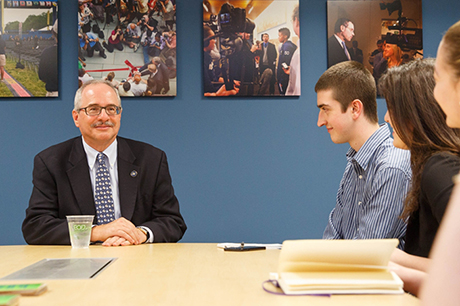After an intensive national search, GW’s board of trustees unanimously approved the appointment of Thomas J. LeBlanc as the university’s 17th president on January 6th. Dr. LeBlanc will begin his service at George Washington on August 1, 2017.
An accomplished academic leader, administrator and professor, Dr. LeBlanc currently serves as executive vice president, provost and professor of computer science and electrical and computer engineering at the University of Miami. He is both the chief academic officer and the chief budget officer, responsible for the university’s 11 schools and colleges, the library system, the division of student affairs, the division of continuing and international education and undergraduate education, admissions and financial aid.
“It is a tremendous honor to be selected to lead the George Washington University,” said Dr. LeBlanc. “I look forward to building on the work of President Knapp, the Board of Trustees and the university’s outstanding students, faculty and staff who have contributed to creating not only a world-class research university, but also a vibrant and distinctive educational experience in the heart of our nation’s capital.”
Dr. LeBlanc succeeds current George Washington President Steven Knapp, who will complete 10 years at the helm of the university when he steps down at the end of July 2017.
Board of Trustees Chair Nelson Carbonell, B.S. ’85, noted that he was particularly struck by the reference calls he made for Dr. LeBlanc. Over and over, he got the impression that Dr. LeBlanc “was someone in the computer science world we call WYSIWYG: what you see is what you get.”
Dr. LeBlanc has already begun the transition process, and that has included meeting small groups of the GW community. In sharing his thoughts with GW Today, this is what he said about social mobility:
“There’s a recent study about the role of higher education in social mobility, and I think that was an important study. It was the first time that they linked enrollment to economic outcomes in social mobility. They looked at universities and [asked] is this university an engine for social mobility or not an engine for social mobility? If everyone you admit comes from the top 1 percent, and after they graduate they are in the top 1 percent, I don’t know what you’ve done, but you haven’t done social mobility. The way you do social mobility is that you admit some fraction of your student body from the lowest quintile, the second lowest quintile."
"This study looked at the bottom 20 percent and the bottom 40 percent, and you actually produce graduates who end up in the top two quintiles - that’s social mobility. I think that’s an admirable goal for higher education. I think I’m a product of social mobility through higher education.”
Welcome Mr. President! GW Names Thomas LeBlanc as 17th President
February 16, 2017

Incoming President Thomas LeBlanc in a meeting with GW students. (Logan Werlinger/GW Today)

